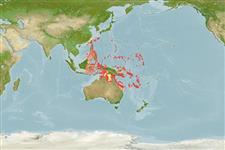>
Acanthuriformes (Surgeonfishes) >
Acanthuridae (Surgeonfishes, tangs, unicornfishes) > Acanthurinae
Etymology: Ctenochaetus: Greek, kteis, ktenos = comb + Greek, chaite = hair (Ref. 45335); cyanocheilus: Named for its blue lips (Greek 'cyano' for blue and 'cheilos' for lip)..
More on authors: Randall & Clements.
Environment: milieu / climate zone / depth range / distribution range
Ecología
marino asociado a arrecife; rango de profundidad 1 - 60 m (Ref. 90102), usually 7 - 15 m (Ref. 48637). Tropical; 28°N - 24°S, 115°E - 67°E (Ref. 37792)
Distribución
Países | Áreas FAO | Ecosistemas | Ocurrencias, apariciones | Point map | Introducciones | Faunafri
Western Pacific: Ogasawara Islands, south through the Philippines and Indonesia to the Great Barrier Reef and New Caledonia, east to Samoa in the South Pacific, to the Marshall Islands.
Tamaño / Peso / Age
Maturity: Lm ? range ? - ? cm
Max length : 16.0 cm SL macho / no sexado; (Ref. 48637)
Espinas dorsales (total) : 8; Radios blandos dorsales (total) : 25 - 28; Espinas anales: 3; Radios blandos anales: 22 - 26. Color orangish brown to dark brown with bluish lines following scale rows; chest with bluish cast; head, anterior body above pectoral-fin base, and chest with very small pale yellowish spots; lips blue; orbit narrowly rimmed with dull yellow. Median fins dark brown, dorsal with bluish lines extending in from body. Young bright yellow. Lip margins smooth to finely papillate. Caudal fin emarginate (Ref. 42056).
Inhabits inner to outer reef with rich coral growth, usually on upper part of slopes in 7-15 meters depth (Ref. 48637). Solitary or in groups, grazing on algae (Ref. 90102). Maximum depth reported taken from Ref. 128797.
Life cycle and mating behavior
Maturities | Reproducción | Spawnings | Egg(s) | Fecundities | Larva
Randall, J.E and K.D. Clements, 2001. Second revision of the surgeonfish genus Ctenochaetus (Perciformes: Acanthuridae), with descriptions of two new species. Indo-Pac. Fish. (32):33 p. (Ref. 42056)
IUCN Red List Status (Ref. 130435)
Threat to humans
Harmless
Human uses
Herramientas
Special reports
Download XML
Fuentes de Internet
Estimates based on models
Preferred temperature (Ref.
123201): 25.2 - 29.3, mean 28.6 °C (based on 1221 cells).
Phylogenetic diversity index (Ref.
82804): PD
50 = 0.5020 [Uniqueness, from 0.5 = low to 2.0 = high].
Bayesian length-weight: a=0.02344 (0.01098 - 0.05004), b=2.97 (2.80 - 3.14), in cm total length, based on LWR estimates for this (Sub)family-body shape (Ref.
93245).
Resiliencia (Ref.
120179): Alto, población duplicada en un tiempo mínimo inferior a 15 meses (Preliminary K or Fecundity.).
Fishing Vulnerability (Ref.
59153): Low vulnerability (10 of 100).
Nutrients (Ref.
124155): Calcium = 41.8 [25.9, 70.7] mg/100g; Iron = 0.263 [0.142, 0.645] mg/100g; Protein = 18 [17, 19] %; Omega3 = 0.133 [0.085, 0.215] g/100g; Selenium = 19.9 [11.3, 35.8] μg/100g; VitaminA = 54.4 [12.5, 216.9] μg/100g; Zinc = 0.432 [0.316, 1.460] mg/100g (wet weight);
